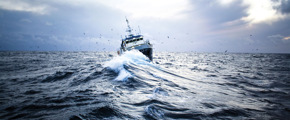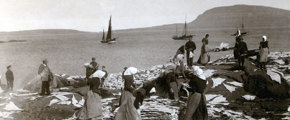Plaice
Plaice is a flat fish that hides in sandy sea beds and can be recognised by its smooth grey or brown skin with red spots. Plaice has a moist texture and a delicate, distinctive taste.
Plaice has a very fine delicate texture and requires a very gentle touch when cooking. The meat is easily damaged, but when prepared correctly, the consistency is almost creamy and worth the extra effort.
Plaice is a lean fish and cooks quicker than other flatfish. This is easily prevented by using wet cooking methods, such as brining, boiling or breading – or by keeping the skin on while cooking.


Plaice has a distinct umami-like taste that stands well on its own. It is therefore preferable to serve plaice that is cooked separately and then paired with other foods. Plaice can be paired with just about any taste or texture. As the meat is very delicate, it works best in contrast with firm or crispy textures. An example could be vegetables that are cut very thin and oven-baked.
Plaice is a great source of protein. It also has a high content of selenium, vitamin D and vitamin B12.

Biology
Plaice is the common name for a group of flatfish that comprises four species: the European (Pleuronectes platessa), American (Hippoglossoides platessoides), Alaskan (Pleuronectes) quadrituberculatus and scale-eye plaice (Acanthopsetta nadeshnyi).
Faroese vessels mainly fish for the European plaice, which is probably the most well-known and popular variety of flatfish. In the Faroe Islands plaice is called reyðsprøka (red plaice).
The plaice is a flounder fish that lives on the sea floor and likes to hide in sandy sea beds. It is a benthic fish, being denser than water, so it can rest on the sea floor. Its head is small as is its eyes.
When young, plaice keep to the shallows, but migrate to a depth of around 200 metres as they mature.
Plaice are mostly active during the night and will move closer to shore to feed while it is dark. During the day they are largely still and remain buried under a layer of sand to hide from predators.
They mostly eat bristle worms, crustaceans and certain types of molluscs.


The plaice has a brown or grey colour with very distinctive red or orange spots on its back, with a white stomach. The brown or grey colour on the back will change to adapt to the plaice’s surroundings, to better hide itself. The trouble is that the spots do not change colour and therefore remain highly visible. As the plaice ages, the spots develop a white circle around them.
The plaice has a dorsal fin and a posterior fin that cover nearly the entire body. They can grow to 100 cm in length, but are normally about 50 to 60 cm long when caught.
The male plaice becomes sexually active relatively quickly and is ready to procreate at around 2 or 3 years. For the female it takes twice as long. They will spawn during the height of winter and their eggs and larvae mature slowly. When the plaice hatches, one eye is located on each side of its head.
As the fish grows from the larval stage, one eye migrates to the other side of the body as a process of metamorphosis. Plaice will remain on the ocean surface until they have fully developed, and the left eye has shifted completely to the right side.
Plaice can be found all over the southwest coast of Europe and up the Norwegian coast, with stocks of plaice all around the Faroe Islands.
The Faroe Islands fish for plaice in Iceland and Greenland, but the vast majority is fished around the coasts of the Faroe Islands. Faroese vessels use otter trawls to fish for plaice.






